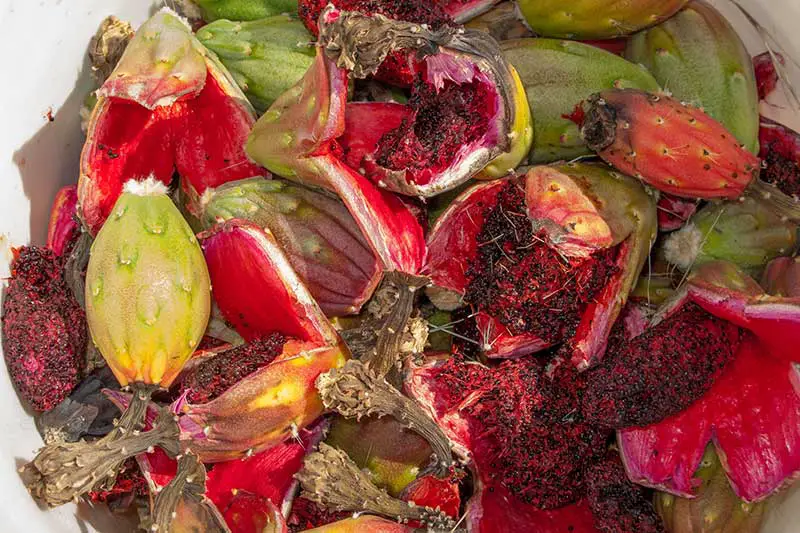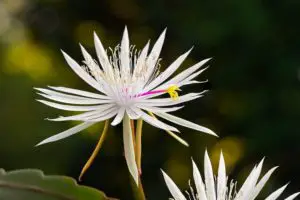Have you ever looked at a cactus and wondered to yourself if it was edible and what it might taste like?
Are Cacti Edible?
While most people might think cactus are inedible, the fact of the matter is that nearly all fruits of cacti can be eaten, and other parts are sometimes edible as well. Not only are they edible, but they are also tasty and nutritious!
Read on to discover five commonly eaten species of cacti, what parts are eaten, and how they might be prepared.
Prickly Pear Fruits And Pads (Opuntia)

The fruit of the prickly pear grow from the flat prickly pads of the cactus.
These prickly pads are also edible, but most people stick to the fruit.
The fruit can be green or red. As the fruit ripens, it goes from green to various shades of orange to red.
The green fruits are a bit tart, while the red ones are very sweet.
This fruit is also called tuna or nostle, and the prickly pads are also called nopal.
Tuna is the Atún word for fruit. Nopal originates from the Nahautl word nōpalli meaning paddle.
Nostle is from the Nahuatl word nōchtli for fruit or paddle cactus.
Unlike the pads that contain sharp thorns that are easy to see, the fruit contains prickly hair like splinters, known as glochids on their skin.
These glochids can penetrate the skin and cause irritation, which is why it is important to wear the proper gear when picking and preparing this delicious fruit.
Protective leather gloves or a thick towel will get the job done. I typically use paper towels stacked together, six to eight usually work great, and gently use a twisting motion until most of the splinters are removed.
Eating The Prickly Pear Cactus Fuit

After you have your harvest of prickly pear fruit, the next step is to remove any of the remaining glochids.
This can easily be done by lightly roasting them over an open flame using a pair of tongs.
Once you can see black spots where the glochids were, you can be confident that they are gone.
To gain access to the delicious soul of the prickly pear, you will need to remove the skin.
Start by cutting off the end of the fruit. (about a quarter of an inch is usually enough).
Then slice the skin lengthwise across the top of the fruit. You should now be able to easily peal the skin from the fruit using your fingers.
The inside of prickly pear fruit has hard seeds that cannot be chewed.
You can chew around them and spit them out, remove them before eating the fruit, or strain them out by smashing the fruit through a strainer or juicer.
Nutritional Benefits
Prickly pear is rich in essential fatty acids, antioxidants, and carotenoids (more so in red fruits), high in fiber, and full of important vitamins and minerals like magnesium, calcium, potassium, iron, Vitamin A, and Vitamin C.
Dragon Fruit (White Fleshed Pitahaya)

Dragon fruit is probably one of the most unique and bizarre cactus fruits you will ever eat.
This fruit comes from the Cactaceae family of climbing cacti and develops from a flower produced by the cacti.
The flower opens at night where it is pollinated by moths and bats.
Dragon fruit is also known as strawberry pear, pitaya, or pitahaya.
Pitaya and pitahaya are actually two distinctly different varieties of dragon fruit.
Pitaya comes from the Stenocereus genus and is sour, while Pitahaya comes from the Hylocereus genus and is sweet.
Eating Dragon Fruit

Dragon fruit is incredibly easy to prepare.
Many claim the flavor is best when the fruit is chilled before preparing.
To prepare, all you have to do is cut the fruit in half length wise and scoop out the fleshy goodness that lies within using a spoon.
The flesh may be white or pink in color and contains tiny black seeds that are reminiscent of kiwi fruit. Just remember that the skin is not edible.
Dragon fruit can be eaten raw, put in smoothies, or even turned into sorbet!
The unopened flower buds can also be eaten and are typically cooked like vegetables.
Nutritional Benefits
Dragon fruit is a good source of vitamin C and vitamin A, as well as minerals like calcium, magnesium, and phosphorus.
It is also high in fiber and low in calories, making it a great diet food.
Saguaro

The saguaro cactus is the largest cactus that grows in North America.
The fruits develop from flowers that form at the top of the cactus.
They are 2-3 inches long, scaly, and round. Like the prickly pear, the fruit ripens from green to red.
When it is completely ripe, the fruit will split open exposing the bright, deliciously red flesh. Like the dragon fruit, it also contains many small black seeds.
Harvesting the fruit is an American Indian tradition.
In June, when the fruits are ripe, the Native Americans live in cactus camps in areas densely populated with Saguaro.
To harvest this fruit, you will need a pole that is 15-30 feet long that can knock the fruits off the top of the cactus.
Eating Saguaro Fruit

After the fruit has been harvested in needs to be separated from the husk.
If the fruit is not already split, you can spit it yourself using a knife.
Then your can remove the pulp and seeds with a spoon.
Traditionally the fruit pulp and seed mixture are dumped into hot water and soaked for up to three hours.
After soaking the fruit is mashed in the water by hand and thoroughly mixed.
The liquid can be consumed at this point; however, it is usually boiled for about two hours to prevent the fermentation process from beginning.
The mixture is then strained to remove the remaining pulp and seeds.
The resulting liquid is then simmered to a thick syrup where it can then be made into jam, dried fruit leather, or wine.
The fruit can also be used raw to make fruit salsa, and the seeds can be saved and dried for grinding into flour.
Nutritional Benefits
Saguaro fruit is a highly nutritious low-calorie food that is high in protein, soluble fiber, vitamin B12, and vitamin C.
Barrel Cactus

Nearly all parts of the barrel cactus are edible, minus the thorny outer skin of the cactus itself.
Even the roots have been harvested after the cactus has fallen off after a storm.
Barrel cactus fruits are one of my favorites, because they are easy to pick and spineless.
They can be picked, and the flesh and seeds eaten raw straight off the cactus.
They have a tart flavor similar to lemons. The seeds add a somewhat nutty flavor.
The fruit starts out green and gradually ripens to a bright yellow, which is the best time to harvest them.
Simply pluck them off with your hands or cut them from the cactus at the base of the fruit.
Eating Barrel cactus

In addition to being eaten raw, the barrel cactus fruit can also be cooked.
The seeds can be removed, dried, and toasted. They are a great addition to breads, yogurt, and granola.
To remove the seeds, simply cut the fruit in half. Let the seeds dry in place for one to three days, then remove them with a spoon and dry roast in a hot pan.
The fruit left after scooping out the seeds can be used in dishes like chutney.
Cut them into smaller bits and use in your favorite chutney recipe.
They can also be turned into delicious candied fruit treats.
Nutritional Benefits
Barrel cactus fruit is high in vitamins A and C.
The pulp also contains analgesic properties and is high in fiber.
Like many other cacti fruit, it is a low-fat, low-calorie food, making it a great addition to any healthy diet.
Cereus Peruvianus

Unlike many other cacti species, the Cereus Peruvianus is a fast-growing cactus that produces a delicious fruit that looks like an apple.
Hence, why it is commonly known as the apple cactus.
As a cousin of dragon fruit, the Cereus Peruvianus has a fleshy inside that is very similar to its cousin.
The fruit of Cereus Peruvianus is round with skin that turns from blue-purple to orange-red when ripe.
The skin of the fruit will split when it is fully ripened and ready to be picked.
The skin is smooth and spineless. When ripe, the fruit should be easy to hand pluck from the cactus.
Eating Cereus Peruvianus

This fruit is among the easiest of cactus fruits to prepare. When ripe the skin is easy to peel and sometimes will just fall off.
The inner flesh can be scooped out and prepared the same ways as the dragon fruit.
The flavor is very mildly tart, with hints of sweet floral goodness.
It is very refreshing and delightfully juicy.
Nutritional Benefits
Like its cousin the dragon fruit, Cereus Peruvianus is high in vitamin C and A, and is a good source of minerals such as magnesium, phosphorus, and calcium.
Lower in sugar, it is potential option for diabetic diets.
Commonly underappreciated, cactus and their fruits are an excellent and tasty food source.
Do you have a favorite cactus that you eat or a fantastic recipe to share?
Please share them in the comments🙏🏻



Thank you!!!! I have a huge Cereus Peruvianus-type (in the family) …. and I have had people drive by and ask if they can take the fruit….so I decided to check on the edibility of this plant and your page here is simple and to the point with great photos…. A+!
Thanks…I will read more of what you have to offer!
CP
Same here! So cool! Awesome large beauty and I am happy to know fruit is edible! Small green now but I am patient and eager to try these! Thank you for the information!!
I have many of the Cereus Peruvianus cactus as well, and never once thought about any of it being edible. But awhile ago, the young man who is my gardener..when I asked him to plant one of them that was still in a pot (I have many HUGE and very TALL of these) and he asked me if I ever ate the fruit! I sad no. He told me how people LOVE to eat the fruit…he even ate TWO of them while working.
So I read your article here and then cut into one and at most of it and loved it!
Thanks!
Dear Sirs,
Thank you for posting this information. The cactus family has been a long forgotten food source for people and animals. The Mandacaru Cactus family should also be a topic of discussion. Encyclopedia Britannica reports that this cactus is a livestock fodder. The stems of this cactus can feed cattle in droughts. I am looking forward to learning from your insight.
Sincerely,
Annatosha MElissa Trump
good information. Prof Bir Bahadur
I have a type of cactus is it edidble to consume .
Its a leafy type .
How can I have this Cereus Peruvianus. I’m very much interested in planting this cactus plant.
I’ve seen both seeds, and, cuttings on Ebay, Amazon, Mercari, OfferUp, Bonanza, and, several other sites – for all of these, and, more. I also noticed that Home Depot, and, Lowe’s carry juveniles of several of these in the Garden Center. Many varieties, and, hybrids to choose from. The lowe portions of grafted cacti often produce edible fruit.
The Prickly Pear fruit is absolutely delicious! I found that I have had fewer digestive upsets and my skin is not as dry as it was previously. While checking the internet I found that prickly pears are loaded with vitamins and minerals and are great for diabetic consumption. Living in a New England state, I have only found 2 stores that carry them and that is not frequently. Please try this amazing fruit!